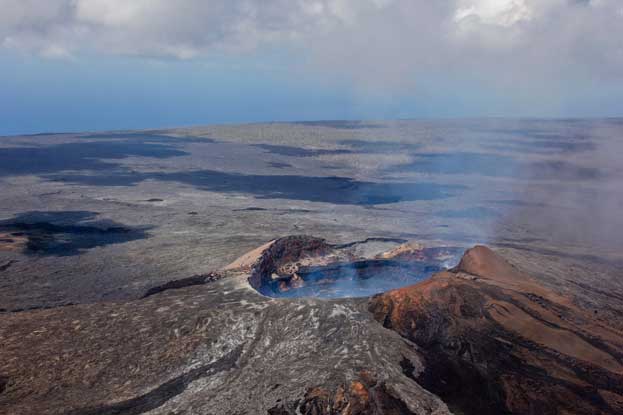Volcanoes National Park Hawaii, contains two of the most active volcanoes in the world, Mauna Loa and Kilauea both of which tower over the Pacific Ocean. Volcanic eruptions have created a constantly changing landscape, and the lava flows reveal surprising geological formations. Rare birds and endemic species can be found there, as well as forests of giant ferns. Hawaii Volcanoes National Park contains Mauna Loa and Kilauea, two of the world's most active and accessible volcanoes where on-going geological processes are easily observed. This property serves as an excellent example of island building through volcanic processes. Through the process of shield-building volcanism, the park's landscape is one of relatively constant, dynamic change.

Continent: North America
Country: United States of America
Category: Natural
Criterion: (VIII)
Date of Inscription: 1987
Kilauea, the most active volcano in the world
The island Lies in the south-east part of the island of Hawaii (Big Island), the easternmost island of the State of Hawaii, and includes the summit and south-east slope of Mauna Loa and the summit and south-western, southern, and south-eastern slopes of the Kilauea Volcano. The park extends from the southern coast, with its volcanic sea cliff headlands to the summit calderas of Kilauea, the most active volcano in the world (with more than 50 recorded eruptions in the last 33 years up to 1985) and Mauna Loa volcanoes. The latter is a massive, flat-domed shield volcano built by lava flow layers and is considered to be the best example of its type in the world, extending from 5,581 m below sea level to 4,169 m above.The Hawaii Volcanoes National Park is greatest and the calderas of Kilauea are one of most studied in the world: in fact there is a geologic station dating from 1912. The climatic gradient varies with altitude from tropical humid to alpine desert.
 |
| Volcanoes National Park Hawaii |
Browse Gallery Plus UNESCO Storyline
The park contains a high diversity of plant communities with striking life-form and physiognomic differences; 23 distinct vegetation types have been described for the park, ranging from the very diverse tropical rainforest of 'Ola'a to the scrub and grassland of Ka'u and the alpine tundra of Mauna Loa, grouped into five major ecosystems: subalpine, montane seasonal, montane rainforest, submontane seasonal and coastal lowlands. The 'Ola'a Forest tract, over 4,000 ha in size, is probably the largest remaining tract of virgin ohia and fern forest in the Hawaiian Islands. The native flora numbering 41 species, with a further 40 listed as rare and warranting special attention.
The park is rich, in archaeological remains particularly along 'the coast with native villages, temples, graves, paved trails, canoe landings, petroglyphs, shelter caves and agricultural areas. Following the arrival of Captain James Cook in 1778-79, Christian influences started in or around 1823, with churches and schools built and the introduction of cattle, goat and pulu (tree-fern product) harvesting and the encouragement of visitors. Extensive ruins of stone structures dating back to the time of Pa'ao (a high priest) in 1275 are present.
Like all natural areas in Hawaii, the park has been subject to considerable biological alteration since man's arrival. Direct removal or alteration of native forest for growing sugar and pineapple plantations, ranching and logging, has altered the native biota of the forest habitats, particularly at low and middle elevations. Except for a single species of bat Hawaiian hoary bat, native mammalian forms are absent. Little is known to date about invertebrate forms.
Avian forms present interesting and significant examples of adaptive radiation and of extinction. Most endemic avian species are rare or endangered. Ranching activities and the introduction of species such as the pig, goat and mongoose have had serious biological consequences, including destruction of native ecosystems and widespread extinction of endemic species. Pockets of standing water, created by the wallowing of the feral pigs, provide breeding places for mosquitoes, resulting in serious avian malaria.
The control programs undertaken on the basis of solid scientific research have been a model for removal of alien animals and plants (including illegal narcotics) on oceanic islands.











No comments:
Post a Comment